
Chameleon Kimono

It is well-known that industrially dyeing textiles uses (and pollutes) an enormous amount of water. In response to the water wastage crisis, Dutch designer Nienke Hoogvliet has created a kimono that has been dyed using byproducts from the wastewater treatment process. She has said that he intends this kimono to be passed down through the generations. This project was the outcome of a collaboration with the Dutch Water Authorities, who have been looking at possible ways to transform the wastewater treatment process in order to produce more clean water and clean energy.

Hoogvliet created the Kaumera kimono using kaumera, which is an alginate-like material that is a byproduct of the wastewater treatment process. It has unique functional properties and was developed by the Delft University of Technology. In the kaumera sludge lives bacteria that form a biopolymer, which has the capacity to both repel and retain water. This, and the fact that its properties change when combined with other substances, makes the material very versatile. It is useful in dyeing cloth as kaumera improves the ability of textiles to absorb dye, so less water is used.

Hoogvliet chose to design a kimono because she was inspired by the durability of traditional Japanese clothing. She is critical of throwaway fashion, so wanted to pay homage to a culture which made clothes to last for decades. In her battle against waste, even the two natural dyes Hoogvliet used to colour the kimono were extracted from wastewater: anammox and vivianite.
Blog post by Jessica Edney. Read more about the Kaumera Kimono in Sophie Vent's article Clean Clothes in the current issue. Subscribe to Selvedge here.
